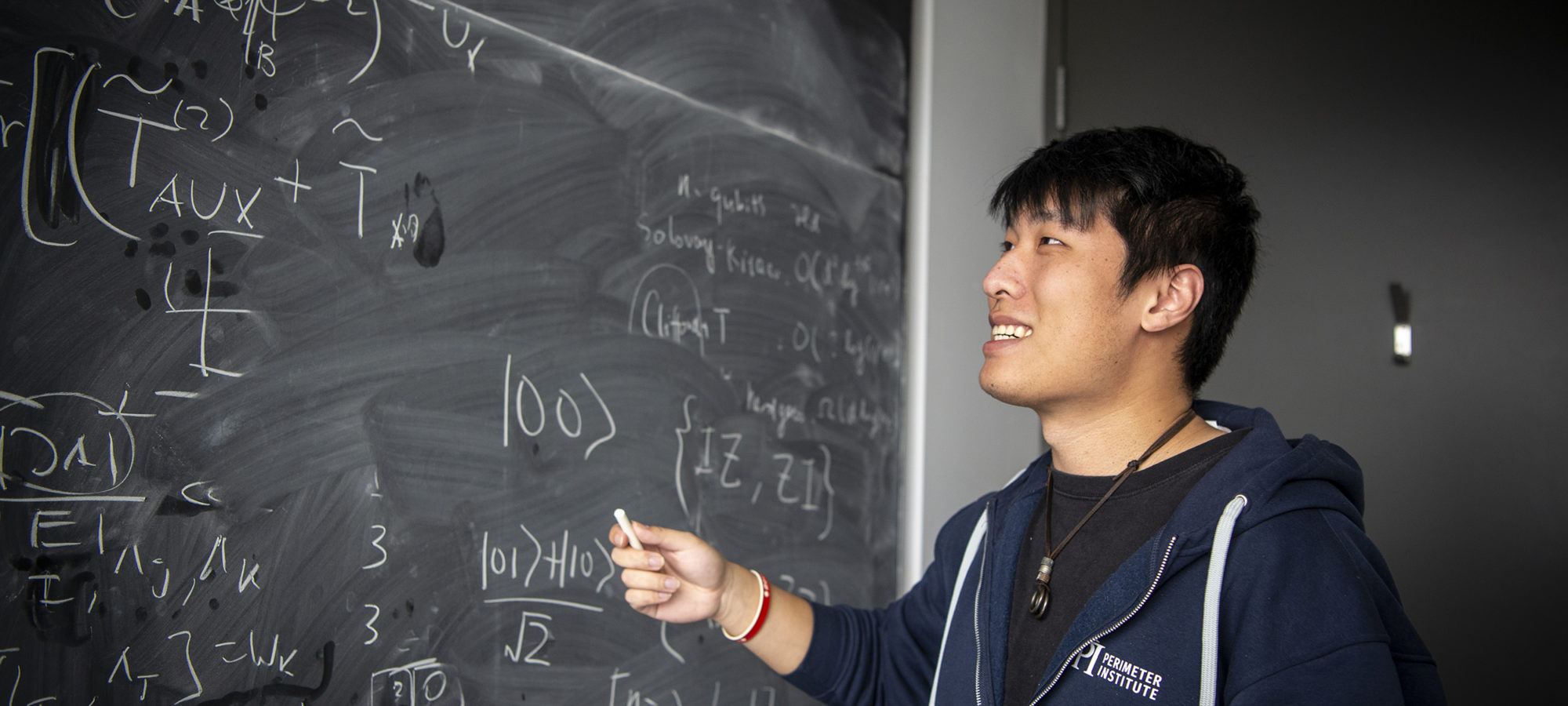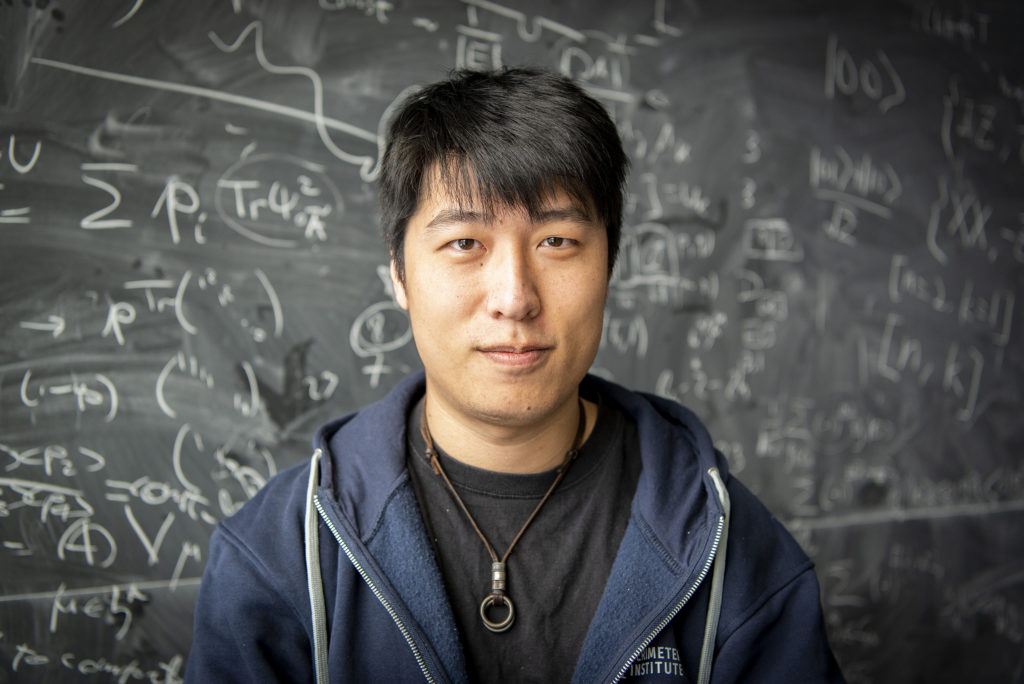An all-powerful quantum juicer
A Perimeter postdoctoral researcher and collaborators have created a practical quantum resource theory framework that has important implications for quantum computing, quantum communication, and more.
Take a self-guided tour from quantum to cosmos!
A Perimeter postdoctoral researcher and collaborators have created a practical quantum resource theory framework that has important implications for quantum computing, quantum communication, and more.

Suppose you own a health food shop and you want to offer customers a variety of juices. Apple, orange, grapefruit, carrot, beet, wheatgrass – something for any appetite you might encounter.
Now imagine that each type of fruit or vegetable requires its own specific juicing equipment. To make apple juice, for example, you need an apple juicer. For carrot juice, a carrot juicer. And so on. The investment required would gobble up your profits, and you’d be ill-prepared to capitalize on the latest trendy superfruits.
Until recently, the field of quantum resource theory commonly operated in a way akin to this, especially in real-life scenarios. Each type of quantum phenomenon – entanglement, for example – was like a different type of fruit, for which a corresponding juicer (or resource theory) must be developed.
That’s about to change thanks to recent work by Perimeter postdoctoral researcher Zi-Wen Liu and collaborators Kaifeng Bu (Zhejiang University and Harvard University) and Ryuji Takagi (MIT). The trio developed a framework – the rough quantum equivalent of a multipurpose juicer – that can characterize the practical usefulness of any quantum resource, regardless of type.
The paper, published in Physical Review Letters, was highlighted as an Editor’s Suggestion. Finding a common thread to unify seemingly disparate theories is a holy grail for many physicists, and Liu’s work toward a generalized framework is expected to have applicability in a range of subfields, including quantum computing and quantum information.
“My way of looking at resource theory is that I just wanted to develop the most powerful juicer with the most functions,” said Liu. “If you care about entanglement, you just put oranges in there, and you get orange juice.” Likewise, he says, you could do so for any other “quantum fruit” – if you want to understand coherence instead, you could throw coherence “apples” into that same juicer.
Quantum resource theories are used to rigorously characterize and evaluate certain quantum effects, which emerge as valuable “resources” that could empower significant advantages over classical methods. Taking a cue from economics, a quantum state attains resource value if it is both useful and nontrivial to obtain. The core of resource theory is the quantification of these values.
What counts as useful? Well, that depends on the user. If you’re looking to build a house, your relevant resource would be lumber: effort is needed to grow suitable trees, cut them down, plane them, and treat them. For a chef at a restaurant, good quality ingredients are a resource.
In the quantum realm, various quantum states or properties – like entanglement, coherence, and “magic states” (more on those later) – can all count as resources. To quantify them, a resource theory lays out some basic rules.
“The basic building blocks of a resource theory are a set of free objects and a set of free transformations between objects,” says Liu. “Here the objects are quantum states, and the transformations are quantum operations that take a state to another state.”
“Free” things are things that are easy to do or obtain: free operations represent the procedures that are considered easy to implement, and free states are those trivial to generate through free operations. In the house building example, hammering a nail into a plank of wood would be considered free, but buying the lumber from the hardware store would not.
“We don’t really care about the amount of the easy, useless things. Only the resources – the precious things – we want to know how to evaluate them,” Liu explains. “Now, the question you ask is what kind of resource manipulation can you do with this set of free operations? That’s the idea of resource theory.”
Our hypothetical house builder might wish to find out the largest possible house they can build, given a certain amount of lumber and an infinite supply of nails and workers. A quantum information theorist, on the other hand, might seek to make use of Bell pairs (maximally entangled pairs of qubits) to enhance the efficiency of communication.
Previous research in the field has mostly examined the usefulness of resources on a case-by-case basis, but Liu’s work generalizes the framework to be broadly applicable.
“This work is a unified framework for measuring the value of any quantum state in different contexts through trading tasks with respect to some resource currency,” he says. “You can just plug certain features of vastly different resource theories into this framework, and you can get corresponding results.”
A particularly important advantage of Liu’s theory is that it is tailored to realistic scenarios, where resources are limited and some amount of error could be allowed. Previous bids to create a unified quantum resource theory framework only applied in the so-called asymptotic limit, where an infinite number of resources are available.
“But in practice, in real life, you’re never really given an infinite amount of resources,” he says. “You only trade finite things for finite things.”
With the generalized framework in place, Liu and other researchers are starting to look at its many applications. One stand-out candidate is the field of quantum computing.
“We are working on many different applications of this framework,” says Liu. “For example, one that interests me a lot is to understand the resource costs of realizing fault-tolerant quantum computation via the theory of ‘magic.’”
Magic, in this case, doesn’t actually imply anything supernatural. Instead, it is a specific property of quantum systems that, essentially, puts the “quantum” into “quantum computing.”
According to the Gottesman-Knill theorem (put forth in part by Perimeter Faculty member Daniel Gottesman), without magic, quantum computers can be effectively simulated by classical means, rendering them no more powerful than the classical computers that we use every day.
With an ample supply of magic states, however, a quantum computer could shine, solving certain problems far faster than a classical computer would be able to. This makes magic a highly valuable quantum resource.
But there’s a problem: the production of these magic states requires expensive and unreliable operations. That’s why Liu says it is crucial to understand, and quantify, how to optimize the expenditure of magic resources in practical settings – and his framework allows quantum scientists to do just that.

In fact, Liu has already begun exploring its usefulness in more depth. In another recent work, he and co-author Kun Fang at the University of Cambridge employed the framework to establish that there is a fundamental limit to how much noise reduction, or “purification,” is possible for a given quantum resource. They showed that it is impossible to purify a noisy resource state to a perfect degree. It’s an important result, given that quantum systems are highly susceptible to noise effects that can perturb quantum states and thus destroy their quantum benefits.
“In particular, this indicates a lower limit to the resource cost of magic state distillation, a key procedure that underpins the leading scheme for realizing fault-tolerant quantum computation,” Liu says. That’s useful for getting a grasp on the minimum cost and difficulty of building large-scale quantum computers.
Researchers forecast that the threshold of “quantum supremacy,” where quantum computers make the leap from novelty to true usefulness and begin to tackle problems that classical computers cannot, will soon be crossed. Some teams say they have already stepped over the line: in late October, Google, in partnership with NASA and Oak Ridge National Laboratory, announced that its 54-qubit quantum computer had tackled a calculation exponentially faster than any standard computer could.
In the meantime, the field of quantum information is growing rapidly, with a multitude of researchers honing their focus on quantum communication, quantum cryptography, quantum sensing, quantum complexity, and more.
To achieve the full potential of quantum information processing, it is crucial to understand how to characterize and utilize many different forms of quantum resources. Ultimately, because Liu’s framework could be able to “juice” any of the quantum fruits one might throw at it – even as-yet unknown ones – he says it could have widespread applicability.
“I expect our theory to find far-reaching applications in many different contexts where different forms of quantum resources play a role,” he says.
“The resource theory approaches are receiving a lot of attention at the moment in the community of quantum information, and many other fields, because its language is just so powerful and versatile.”
A Simons Emmy Noether Fellowship has given experimental physicist Urbasi Sinha the opportunity to collaborate with theorists at Perimeter.
Perimeter graduate student helps speed up quantum computing for practical problems
Nicole Yunger Halpern elaborates on a tribute to her former Perimeter Scholars International classmate woven within her new book.